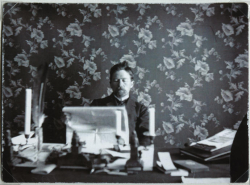Siddhartha Mukherjee in The New Yorker:
 When my mother’s mother began to die of a mysterious, undiagnosable neurological illness, the first thing she lost was her sense of taste. For most families, perhaps, this would be a rather inconsequential loss, but this had severe repercussions for us. As the matriarch of our heaving, multi-generational family, she had always helmed the kitchen with an efficient, if somewhat despotic, hand. Because all the food in that household was cooked by her—years earlier, an attempted takeover by one of the uncle’s wives had been swiftly and tyrannically rebuffed—my grandmother was, in fact, the ultimate arbiter of taste. For decades, this had been a relatively stable and blissful arrangement: she was an acutely talented cook. But as her taste buds numbed, week by week, the food turned from mild to well-seasoned to intolerably spicy. It was, perhaps, a kind of neural compensation for her—the way people with early hearing loss often begin to speak more loudly—but the fish curry now went off on the palate like a thermonuclear bomb. The lentils exfoliated the tongue. The fried spinach was an incinerating terror; the okra, an endurance sport. When even the white rice, the final refuge of the Asian tongue, began to arrive at the table with halved Thai bird peppers on top, the seeds squinting above it, we squirmed in terror. But we steeled ourselves and kept eating: numbness begetting numbness.
When my mother’s mother began to die of a mysterious, undiagnosable neurological illness, the first thing she lost was her sense of taste. For most families, perhaps, this would be a rather inconsequential loss, but this had severe repercussions for us. As the matriarch of our heaving, multi-generational family, she had always helmed the kitchen with an efficient, if somewhat despotic, hand. Because all the food in that household was cooked by her—years earlier, an attempted takeover by one of the uncle’s wives had been swiftly and tyrannically rebuffed—my grandmother was, in fact, the ultimate arbiter of taste. For decades, this had been a relatively stable and blissful arrangement: she was an acutely talented cook. But as her taste buds numbed, week by week, the food turned from mild to well-seasoned to intolerably spicy. It was, perhaps, a kind of neural compensation for her—the way people with early hearing loss often begin to speak more loudly—but the fish curry now went off on the palate like a thermonuclear bomb. The lentils exfoliated the tongue. The fried spinach was an incinerating terror; the okra, an endurance sport. When even the white rice, the final refuge of the Asian tongue, began to arrive at the table with halved Thai bird peppers on top, the seeds squinting above it, we squirmed in terror. But we steeled ourselves and kept eating: numbness begetting numbness.
I want to talk to you today about desensitization. In my other life, I am an oncologist. Numbness, you might say, is my occupational hazard. Over the past month or so, I have watched twelve of my patients die from or relapse with cancer. Yesterday, I heard that a friend who ran my favorite restaurant, the place I went for daily refuge while I was writing my last book, passed away from tongue cancer that had colonized her brain and bones. When interviewers ask me how I carry on carrying on, I speak about the startling successes with some of my patients, about hope and the future. But I do not—I cannot—tell them that a certain kind of numbness must be a part of it. I come home from the bone-marrow-transplant wards on a January morning and play with my dog, rearrange the furniture, and practice polynomial factorization with my daughter. I celebrate a recent laboratory paper with a glass of champagne. I return to the wards the next morning and look down a microscope to find a marrow choked up with leukemia cells after a heroic attempt at salvage chemotherapy. And this cycle repeats. You might say that I have an advanced degree in desensitization. But, of course, I am not here to describe the numbness that accompanies medical practice. There is a different form of desensitization that surrounds us today. When I was asked to give this talk to a roomful of aspiring writers, I had to confront the elephant-in-the-room question: How shall we continue to write in these numbing times?
More here.
Karen Wilkin at The Hudson Review:
